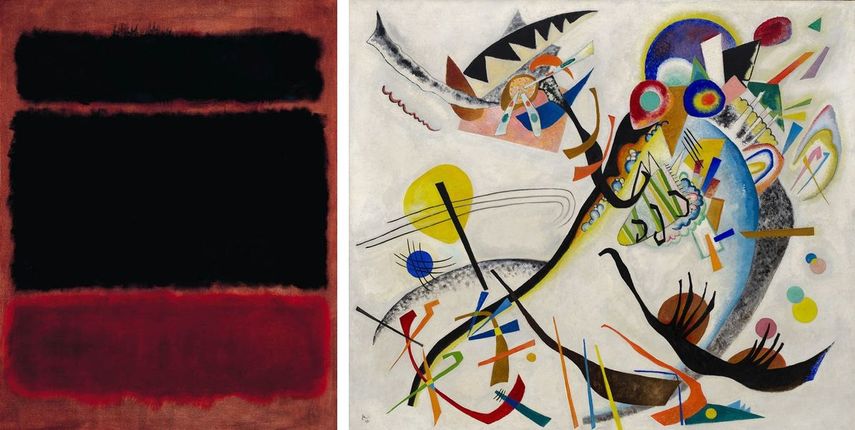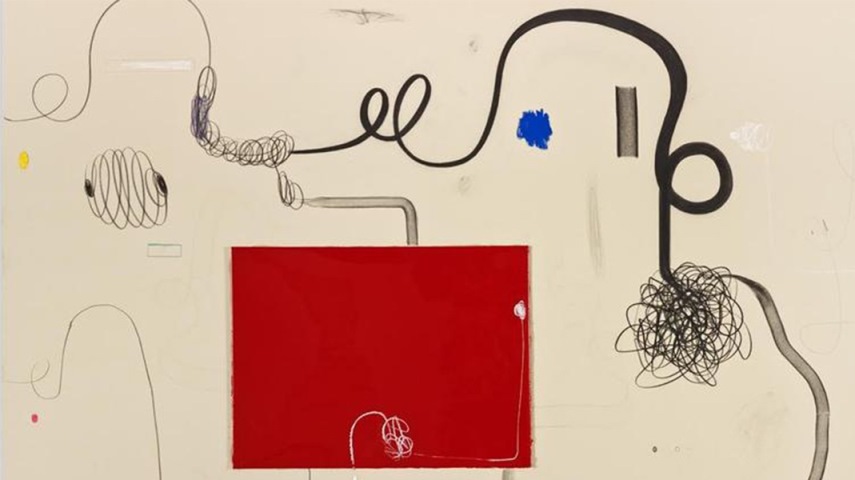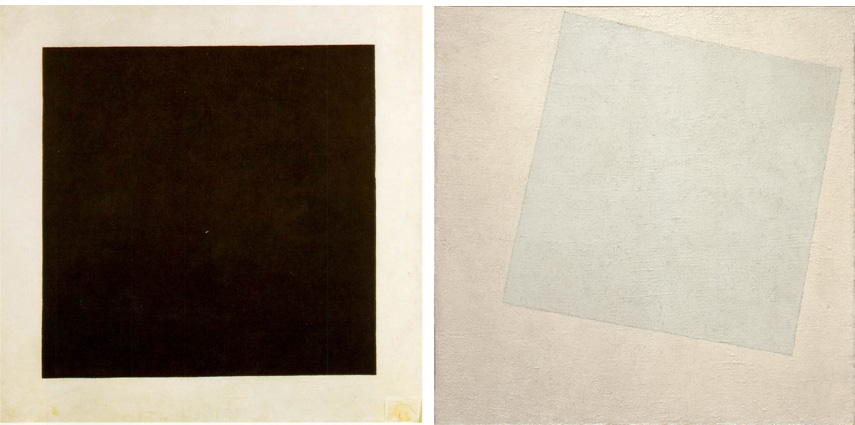Non Objective Art Work Does What Artist Is Expressing
Is there a link between diminutive disintegration and not objective fine art? What about Ernest Rutherford and Wassily Kandinsky? In the early 20th century, discoveries in physics chop-chop inverse the manner we perceive the globe, going as far every bit to show u.s. that even the smallest elective unit of measurement of ordinary matter can be further broken into even smaller particles. Ernest Rutherford, today considered a father of nuclear physics, published Theory of Atomic Disintegration in 1902, together with J.J. Thomson. In the volume, they explicated a radically new idea that the atoms of radioactive substances can exist broken upwardly. It was around the same time that Wassily Kandinsky decided to get out Munich where he studied, and to travel effectually Europe in order to meet what Western art, in his words, "had accomplished to that appointment." This travel was provoked by the mild reception of his works at Berlin Secession exhibition, and Salon d'Automne in Paris in 1904. Suspicious of the theories that find truth of the reality that surrounds us in works of art and familiar with theories nigh disintegration of the atom, Kandinsky started to question the truthfulness of reality that soon led him to define a new line in thinking nearly art, which was concerned not with the real, whatever that real may be, but with the metaphysical.

Kandinsky'southward Spiritual Art
This shift in thinking almost art from representation of reality to representation of 'Stimmung' or essential spirit of nature that will influence and inspire many artists of not-objective art provenance, was elaborated by Kandinsky in his text Concerning the Spiritual in Art . As he writes, in great art:
"The spectator does feel a corresponding thrill in himself. Such harmony or fifty-fifty contrast of emotion cannot be superficial or worthless; indeed the Stimmung of a picture can deepen and purify that of the spectator. Such works of art at least preserve the soul from coarseness; they "key it up," so to speak, to a sure height, equally a tuning-cardinal the strings of a musical instrument." [1]
Run across more works by Wassily Kandinsky on our market!
It is axiomatic that Kandinsky saw art equally a vehicle that helps us to tune in to higher, metaphysical and spiritual spheres which deliquesce the coarseness of the reality, but likewise the materialist, positivist thinking of the 19th century. His move into abstraction was not sudden, all the same, but came gradually over the years, with his first not-objective art piece being a watercolor from 1910. Putting the spiritual in a higher place the material by Kandinsky subsequently on inspired artists to seek the pure, artistic expression disengaged course reality in geometrical forms and colors, which define non-objective art.
Helen Mirren on Wassily Kandinsky
Non Objective Art Definition – the Abstract and the Not-Representational
Non-objective art is a general term that defines abstract art forms that lack adherence to identifiable, quantifiable, and observable characteristics of the living earth. It is oft linked with two seminal figures of Russian art, Alexander Rodchenko and his compatriot Kasimir Malevich, who pioneered abstruse fine art based on geometrical forms and linearity, which is also referred to as geometric abstraction. The term non-objective art was get-go used by Rodchenko when he named some of his pictures, and was later on taken up by other artists, such as Malevich. The latter also wrote a book titled The Non-Objective World: The Manifesto of Suprematism , which was published in 1926. The definition of non-objective art veers around abstract expressions, simply put in simpler terms, it could be said that non-objective art stands for artworks which create a novel world made from the elements that generally mean nothing – such as a foursquare, line, or a daub of color. Suprematism, Constructivism, and De Stijl, with its most famous representative in Piet Mondrian, all belong to the group of non-objective fine art styles which take some mutual differences. While they were all rooted in an effort to change the globe and to create new art that is functional and normative, Suprematism was rooted in pre-revolutionary anarchism in Russia, Constructivism emphasized technological and futuristic aesthetics, while De Stijl adhered to conspicuously defined and delineated aeroplane.

Malevich's Black and White Not-Objective Art
Malevich was amid the offset painters who attempted to attain the platonic of an absolute painting that is cleared from every allusion and objective reference.[2] Maybe the most radical of non-objective artists and theorists, he insisted in his writings that art and the feelings information technology tin can generate are more important than political conceptions and religious beliefs.[3] In 1913 he established Suprematism, and his aesthetics took a plow from that point onward. One of the artworks that would marking Suprematism is his Black Square on a White Basis from 1913. The painting meant to evoke "the experience of pure not-objectivity in the white emptiness of a liberated nothing." [4] It is the first among the series of the so-chosen 'last paintings' in which he tried to achieve the stop of representation that would subsequently lead to a death of painting. As he stated, he just "felt the night within myself, and sensed the new thing I phone call Suprematism." [5] The culmination of his search for ultimate not-objectivity came with his White Square on a White Ground from 1917. With this painting he reached the borderline of pettiness:
"I transformed myself in the zero of form and emerged from null to creation, that is, to Suprematism, to the new realism in painting - to non-objective creation." [six]

Not Objective Art Today
Although it may seem an anachronism to talk about non-objective art today, as the term was used to define fine art in a detail historical context, formal elements of this fine art remain role of artistic explorations even today. Although the context that ushered the advent of non-objective art changed dramatically over the decades, today we see the apply of the same geometrical forms and abstract elements in artworks produced all over the globe. Abstraction entered the creative decorum of modernity and today is a role of the post-mod multiplicity and free play of styles and artistic forms. Christian Rosa, Ben Berlow, Anish Kapoor, Kika Karadi, and Molly Zuckerman Hartung, are just some of the names of artists who create abstruse and non-objective art today. Their works take been analyzed and compared with their historical predecessors, simply they also give a new, and contemporary twist to this fine art mode. Spirituality and search for deeper meanings and emotional engagements seems more pronounced today than ever, and fine art certainly follows this trends. Not just that the not-objective art is alive and kicking today, but nosotros can inappreciably imagine the contemporary art without it.

Editors' Tip: Concerning the Spiritual in Art
A pioneering work in the movement to free art from its traditional bonds to material reality, this book is one of the most important documents in the history of art. Written by the famous nonobjective painter Wassily Kandinsky (1866–1944), it explains Kandinsky'southward own theory of painting and crystallizes the ideas that were influencing many other artists of the period. Forth with his own groundbreaking art, this book had a tremendous touch on the development of fine art. Kandinsky's ideas are presented in two parts. The first role, called "About General Aesthetic," calls for a spiritual revolution in painting, and expression in abstract, non-textile terms. In the 2d role, "About Painting," Kandinsky discusses the psychology of colors, the language of grade and color, and the responsibilities of the creative person.
References:
- Popova M., Kandinsky on the Spiritual Element in Art and the Three Responsibilities of Artists, world wide web.brainpickings.org [Jan 26, 2017]
- Ruhrberg K. et al., (2005), Art of the 20th Century. Painting, Sculpture, New Media, Photography, p.164.
- Malevich Thou., (1926), The Non-Objective World: The Manifesto of Suprematism, p. seven.
- Drutt M., (2003), Kazimir Malevich: Suprematism.
- Ruhrberg Thou. et al., (2005), Art of the 20th Century, p. 165.
- Drutt M., (2003), Kazimir Malevich.
Featured images: Painting by Kazimir Malevich, image via 100architects.com; Wassily Kandinsky - Composition 7, 1913. Courtesy State Tretyakov Gallery Moscow;Alexander Rodchenko - Construction No.95. Image via magazineclick.com. All images used for illustrative purposes merely.
thomasonvorcy1981.blogspot.com
Source: https://www.widewalls.ch/magazine/non-objective-art
0 Response to "Non Objective Art Work Does What Artist Is Expressing"
Post a Comment